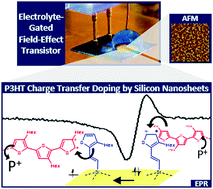当前位置:
X-MOL 学术
›
J. Mater. Chem. C
›
论文详情
Our official English website, www.x-mol.net, welcomes your
feedback! (Note: you will need to create a separate account there.)
Charge transfer doping in functionalized silicon nanosheets/P3HT hybrid material for applications in electrolyte-gated field-effect transistors†
Journal of Materials Chemistry C ( IF 5.7 ) Pub Date : 2018-06-12 00:00:00 , DOI: 10.1039/c8tc01484a Alina Lyuleeva 1, 2, 3, 4 , Philipp Holzmüller 2, 4, 5, 6 , Tobias Helbich 2, 4, 5, 6 , Martin Stutzmann 2, 4, 7, 8 , Martin S. Brandt 2, 4, 7, 8 , Markus Becherer 1, 2, 3, 4 , Paolo Lugli 9, 10, 11, 12 , Bernhard Rieger 2, 4, 5, 6
Journal of Materials Chemistry C ( IF 5.7 ) Pub Date : 2018-06-12 00:00:00 , DOI: 10.1039/c8tc01484a Alina Lyuleeva 1, 2, 3, 4 , Philipp Holzmüller 2, 4, 5, 6 , Tobias Helbich 2, 4, 5, 6 , Martin Stutzmann 2, 4, 7, 8 , Martin S. Brandt 2, 4, 7, 8 , Markus Becherer 1, 2, 3, 4 , Paolo Lugli 9, 10, 11, 12 , Bernhard Rieger 2, 4, 5, 6
Affiliation

|
Hydrogenated two-dimensional (2D) silicon nanosheets (SiNSs), also called silicanes, have lateral sizes ranging from hundreds of nanometers to several micrometers and heights in the nanometer range. Due to the sp3-hybridization and the H-termination, SiNSs possess a band gap, show green photoluminescence and can be functionalized according to the subsequent needs of desired applications. Thus, they are suitable for industrial processing techniques, which involve incorporation in nanocomposites and application in novel nano-silicon based technology. In this work, we present the modification of the silicane surface with various molecules, using a microwave-reactor system for reproducible microwave-assisted thermal hydrosilylation. Subsequently, the modified SiNSs are used for blend formation with the semiconducting workhorse polymer poly(3-hexylthiophene) (P3HT). This hybrid nanocomposite acts as sensitive thin film for electrolyte-gated field-effect-transistors fabrication. The functionalization of the nanosheets can be varied and adjusted to the characteristics of the polymer, to prepare homogeneous hybrid systems. In this regard, thiophene-based conjugated substrates are grafted on the SiNS surface for improved film homogeneity and electrical performance. The fabricated devices are furthermore compared with the silicon-based molecular analogues (polysilanes), as well as with 0D silicon nanocrystals (SiNCs), confirming the superior performance of SiNSs. To elucidate the performance improvement, electron paramagnetic resonance (EPR) measurements are presented, demonstrating charge transfer doping in the hybrid material of P3HT and SiNSs. The corresponding mechanism for the electronic transportation is described in this work.
中文翻译:

功能化硅纳米片/ P3HT杂化材料中的电荷转移掺杂,用于电解质门控场效应晶体管†
氢化二维(2D)硅纳米片(SiNS),也称为硅酮,其横向尺寸范围从数百纳米到几微米,高度在纳米范围内。由于sp 3-杂交和H-端接,SiNS具有带隙,显示绿色光致发光,并且可以根据所需应用的后续需求进行功能化。因此,它们适用于工业加工技术,该技术涉及在纳米复合材料中的结合以及在基于纳米硅的新型技术中的应用。在这项工作中,我们介绍了使用可再生的微波辅助热氢化硅烷化反应的微波反应器系统,用各种分子对硅酮表面进行的改性。随后,将改性的SiNS用于与半导体主力聚合物聚(3-己基噻吩)(P3HT)形成共混物。该杂化纳米复合材料充当电解质门控场效应晶体管制造的敏感薄膜。可以改变纳米片的功能化并调整至聚合物的特性,以制备均质的杂化系统。就这一点而言,将基于噻吩的共轭基底接枝在SiNS表面上,以改善膜的均匀性和电性能。此外,将所制造的器件与基于硅的分子类似物(聚硅烷)以及0D硅纳米晶体(SiNC)进行了比较,证实了SiNS的卓越性能。为了阐明性能的改善,提出了电子顺磁共振(EPR)测量,以证明P3HT和SiNSs杂化材料中的电荷转移掺杂。在这项工作中描述了电子运输的相应机制。将基于噻吩的共轭底物嫁接在SiNS表面上,以提高薄膜的均匀性和电性能。此外,将所制造的器件与基于硅的分子类似物(聚硅烷)以及0D硅纳米晶体(SiNC)进行了比较,证实了SiNS的卓越性能。为了阐明性能的改善,提出了电子顺磁共振(EPR)测量,以证明P3HT和SiNSs杂化材料中的电荷转移掺杂。在这项工作中描述了电子运输的相应机制。将基于噻吩的共轭底物嫁接在SiNS表面上,以提高薄膜的均匀性和电性能。此外,将所制造的器件与基于硅的分子类似物(聚硅烷)以及0D硅纳米晶体(SiNC)进行了比较,证实了SiNS的卓越性能。为了阐明性能的改善,提出了电子顺磁共振(EPR)测量,以证明P3HT和SiNSs杂化材料中的电荷转移掺杂。在这项工作中描述了电子运输的相应机制。以及0D硅纳米晶体(SiNC),证实了SiNS的卓越性能。为了阐明性能的改善,提出了电子顺磁共振(EPR)测量,以证明P3HT和SiNSs杂化材料中的电荷转移掺杂。在这项工作中描述了电子运输的相应机制。以及0D硅纳米晶体(SiNC),证实了SiNS的卓越性能。为了阐明性能的改善,提出了电子顺磁共振(EPR)测量,以证明P3HT和SiNSs杂化材料中的电荷转移掺杂。在这项工作中描述了电子运输的相应机制。
更新日期:2018-06-12
中文翻译:

功能化硅纳米片/ P3HT杂化材料中的电荷转移掺杂,用于电解质门控场效应晶体管†
氢化二维(2D)硅纳米片(SiNS),也称为硅酮,其横向尺寸范围从数百纳米到几微米,高度在纳米范围内。由于sp 3-杂交和H-端接,SiNS具有带隙,显示绿色光致发光,并且可以根据所需应用的后续需求进行功能化。因此,它们适用于工业加工技术,该技术涉及在纳米复合材料中的结合以及在基于纳米硅的新型技术中的应用。在这项工作中,我们介绍了使用可再生的微波辅助热氢化硅烷化反应的微波反应器系统,用各种分子对硅酮表面进行的改性。随后,将改性的SiNS用于与半导体主力聚合物聚(3-己基噻吩)(P3HT)形成共混物。该杂化纳米复合材料充当电解质门控场效应晶体管制造的敏感薄膜。可以改变纳米片的功能化并调整至聚合物的特性,以制备均质的杂化系统。就这一点而言,将基于噻吩的共轭基底接枝在SiNS表面上,以改善膜的均匀性和电性能。此外,将所制造的器件与基于硅的分子类似物(聚硅烷)以及0D硅纳米晶体(SiNC)进行了比较,证实了SiNS的卓越性能。为了阐明性能的改善,提出了电子顺磁共振(EPR)测量,以证明P3HT和SiNSs杂化材料中的电荷转移掺杂。在这项工作中描述了电子运输的相应机制。将基于噻吩的共轭底物嫁接在SiNS表面上,以提高薄膜的均匀性和电性能。此外,将所制造的器件与基于硅的分子类似物(聚硅烷)以及0D硅纳米晶体(SiNC)进行了比较,证实了SiNS的卓越性能。为了阐明性能的改善,提出了电子顺磁共振(EPR)测量,以证明P3HT和SiNSs杂化材料中的电荷转移掺杂。在这项工作中描述了电子运输的相应机制。将基于噻吩的共轭底物嫁接在SiNS表面上,以提高薄膜的均匀性和电性能。此外,将所制造的器件与基于硅的分子类似物(聚硅烷)以及0D硅纳米晶体(SiNC)进行了比较,证实了SiNS的卓越性能。为了阐明性能的改善,提出了电子顺磁共振(EPR)测量,以证明P3HT和SiNSs杂化材料中的电荷转移掺杂。在这项工作中描述了电子运输的相应机制。以及0D硅纳米晶体(SiNC),证实了SiNS的卓越性能。为了阐明性能的改善,提出了电子顺磁共振(EPR)测量,以证明P3HT和SiNSs杂化材料中的电荷转移掺杂。在这项工作中描述了电子运输的相应机制。以及0D硅纳米晶体(SiNC),证实了SiNS的卓越性能。为了阐明性能的改善,提出了电子顺磁共振(EPR)测量,以证明P3HT和SiNSs杂化材料中的电荷转移掺杂。在这项工作中描述了电子运输的相应机制。










































 京公网安备 11010802027423号
京公网安备 11010802027423号